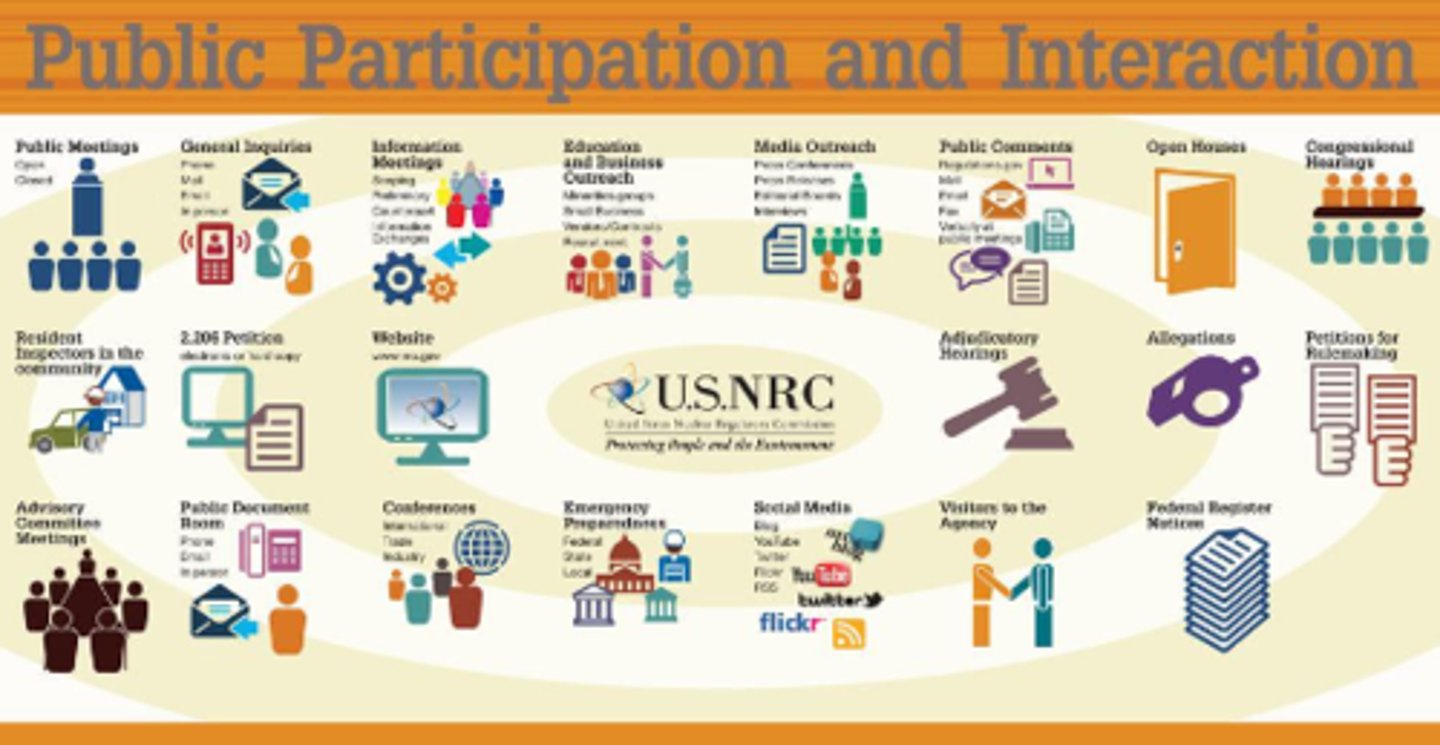Population and Community Health
1/89
There's no tags or description
Looks like no tags are added yet.
Name | Mastery | Learn | Test | Matching | Spaced |
|---|
No study sessions yet.
90 Terms
What term can be defined as the health of all people living in a given place (e.g. New York City, Texas, Rome)?
Population health
Population Health
Health of all people living in a given place (e.g. New York City, Texas, Rome)
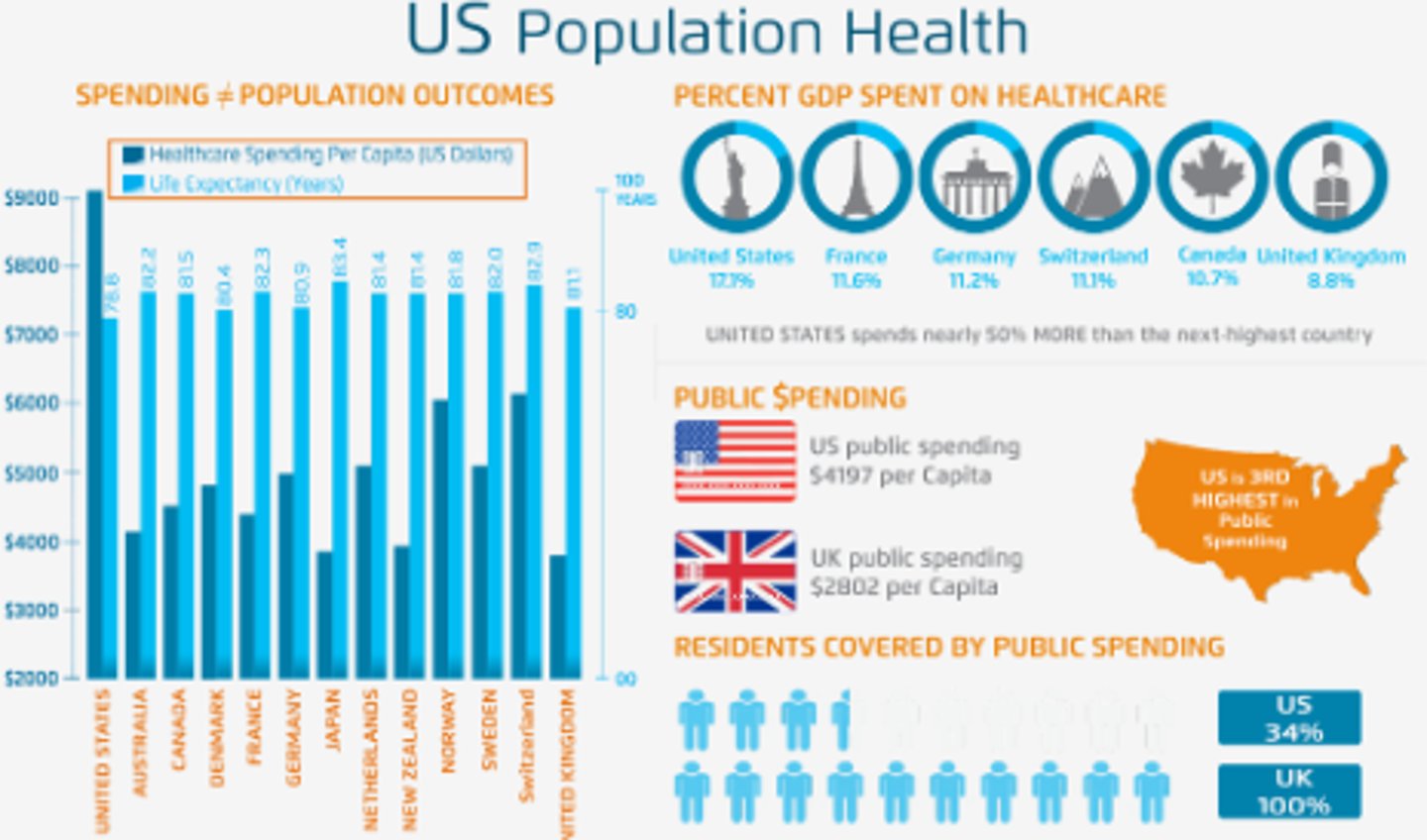
What does population health also refer to as?
Differences in health (e.g. rich vs. poor)
What is population health the product of?
Causes operating at many levels "from cells to society" (e.g. affects the individuals because of things happening in society)
Population Health vs. Public Health
Population health provides an opportunity for health care systems to work together in order to improve the health outcomes of the communities they serve whereas public health works to protect and improve the health of communities through policy recommendations, health education, and research for disease detection and injury prevention
What do policy recommendations drive the delivery of?
Healthcare
What term can be defined as what a society does to collectively assure the conditions in which people can be healthy?
Public health
Public Health
What a society does to collectively assure the conditions in which people can be healthy
What term can be defined as the study of the distribution, frequencies, and determinants of disease, injury, and disability in human populations?
Epidemiology
Epidemiology
The study of the distribution, frequencies, and determinants of disease, injury, and disability in human populations
What term can be defined as the number of new cases of a disease, injury, or disability within a specific time frame (usually a year)?
Incidence
Incidence
Number of new cases of a disease, injury, or disability within a specific time frame (usually a year)
What term can be defined as the total number of cases of disease, injury, or disability in a community, city, state, or nation existing at a specific point in time?
Prevalence
Prevalence
Total number of cases of disease, injury, or disability in a community, city, state, or nation existing at a specific point in time
2 Types of Factors
1. Risk
2. Resiliency
Which type of factor increases an individual’s or population’s vulnerability to developing a disease or disability or sustaining an injury; risk or resiliency?
Risk factor
Risk Factors
Precursors that increase an individual's or population's vulnerability to developing a disease or disability or sustaining an injury (e.g. poor drinking water, air quality)
Which type of factor increases an individual’s or population’s resistance to developing a disease or disability or sustaining an injury; risk or resiliency?
Resiliency factor
Resiliency Factors
Precursors that appear to increase an individual's or population's resistance to developing a disease or disability or sustaining an injury
True or False: Risk and resiliency factors can be internal or external.
True
What can population health be described as from an occupational therapy perspective?
A collaborative and interdisciplinary approach
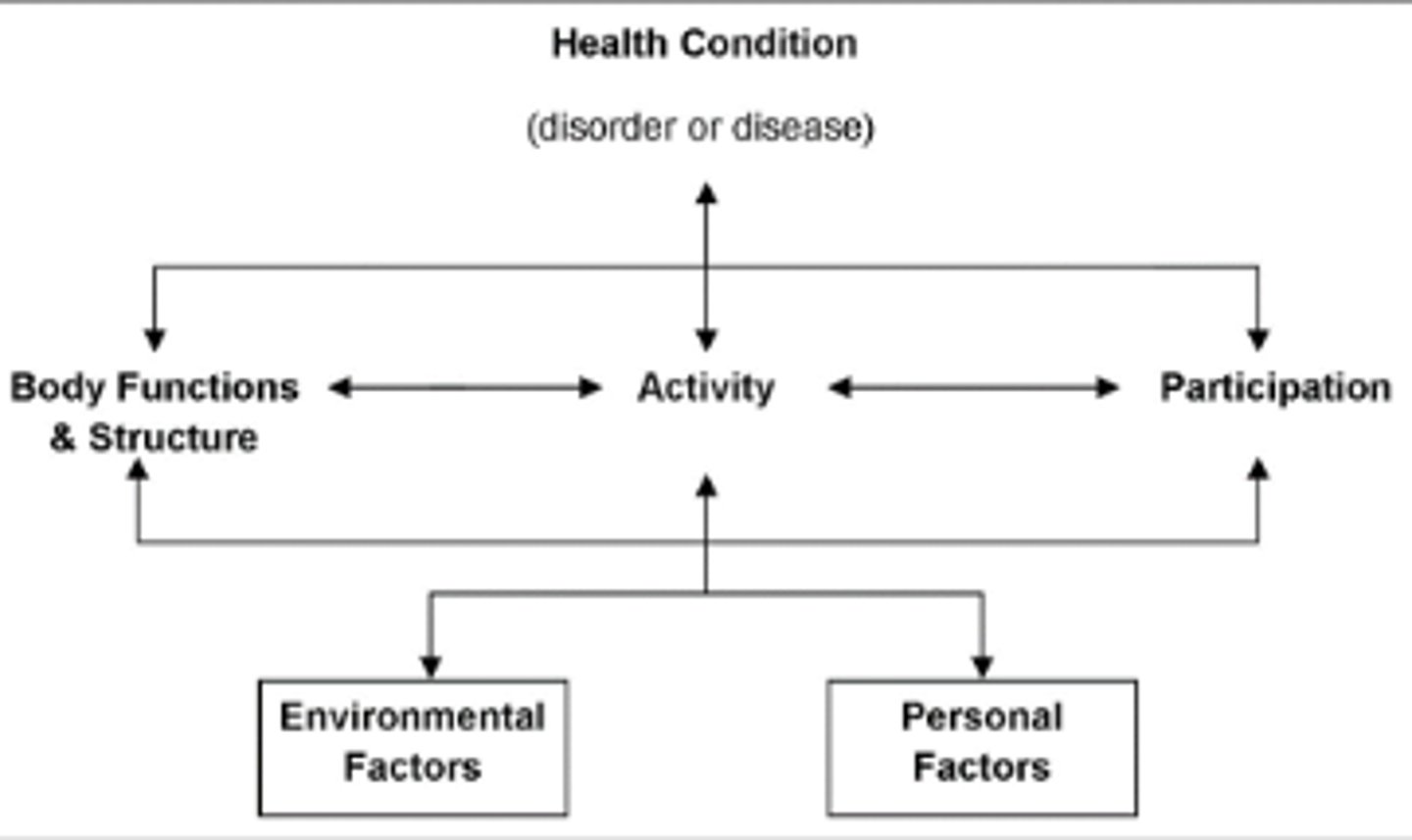
What 5 concepts makeup the occupational therapy perspective of population health?
1. Advocacy
2. Program development
3. Program implementation and evaluation
4. Policy revision and development
5. Occupational justice
Which concept of population health within the occupational therapy perspective accounts for the right of every individual to be able to meet basic needs and to have equal opportunities and life chances to reach toward their potential for engagement in diverse and meaningful occupations; advocacy, program development, program implementation and evaluation, policy revision and development, or occupational justice?
Occupational justice
Occupational Justice
Accounts for the right of every individual to be able to meet basic needs and to have equal opportunities and life chances to reach toward their potential for engagement in diverse and meaningful occupations
According to occupational justice, what do people have the right to participate in? What does this enable?
Right to participate in a range of occupations that enable them to flourish, fulfill their potential, and experience satisfaction in a manner consistent with their culture and beliefs
What is the difference between inequality, equality, equity, and justice?
Inequality: Unequal access to opportunities
Equality: Evenly distributed tools and assistance
Equity: Custom tools that identity and address inequality
Justice: Fixing the system to offer equal access to opportunities
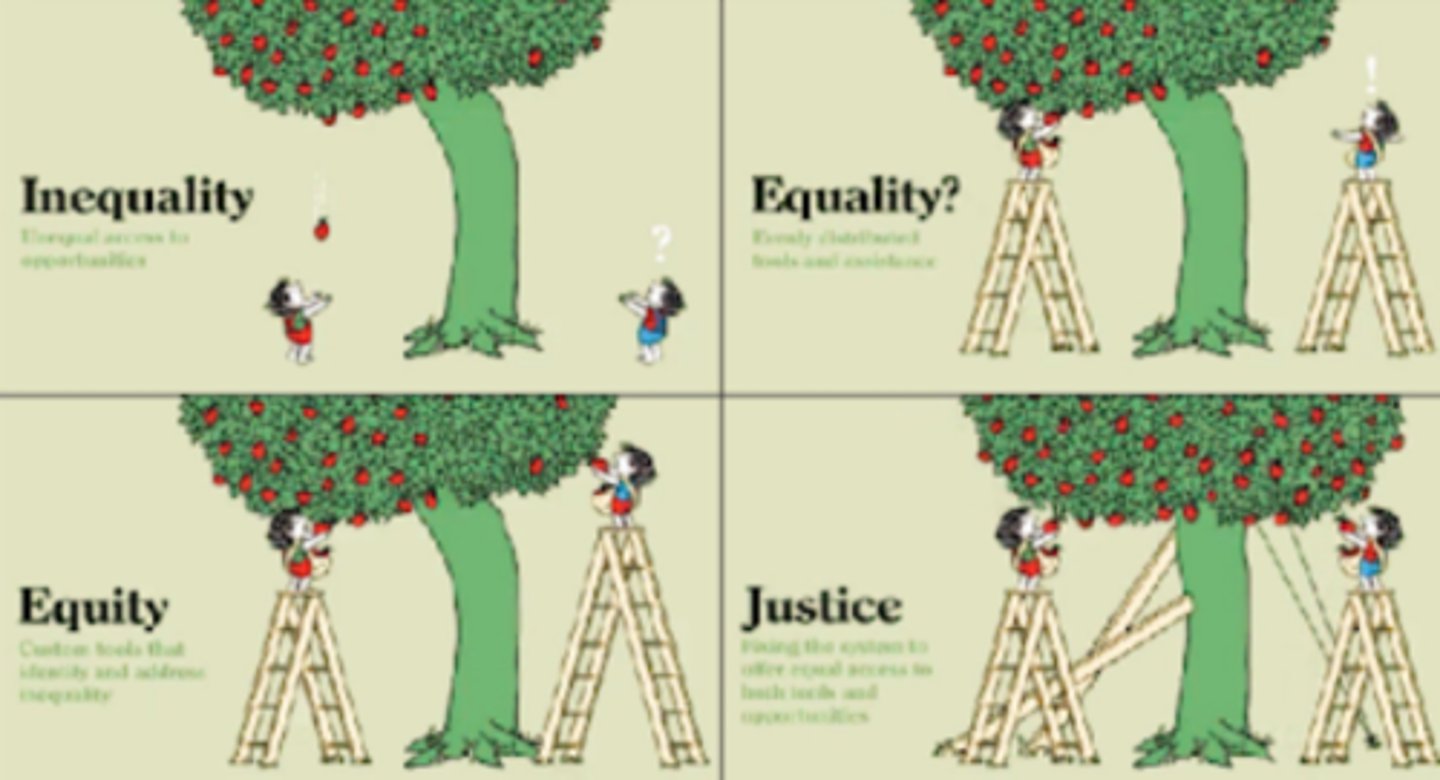
What is essential for population health in occupational therapy?
Understanding how each work together
_____, _____, _____, and _____ are inseparable for population health in occupational therapy.
Doing, being, belonging, and becoming
What can the "doing" aspect of population health in occupational therapy be described as?
Everything of meaning that people do in their lives
Doing
Everything of meaning that people do in their lives
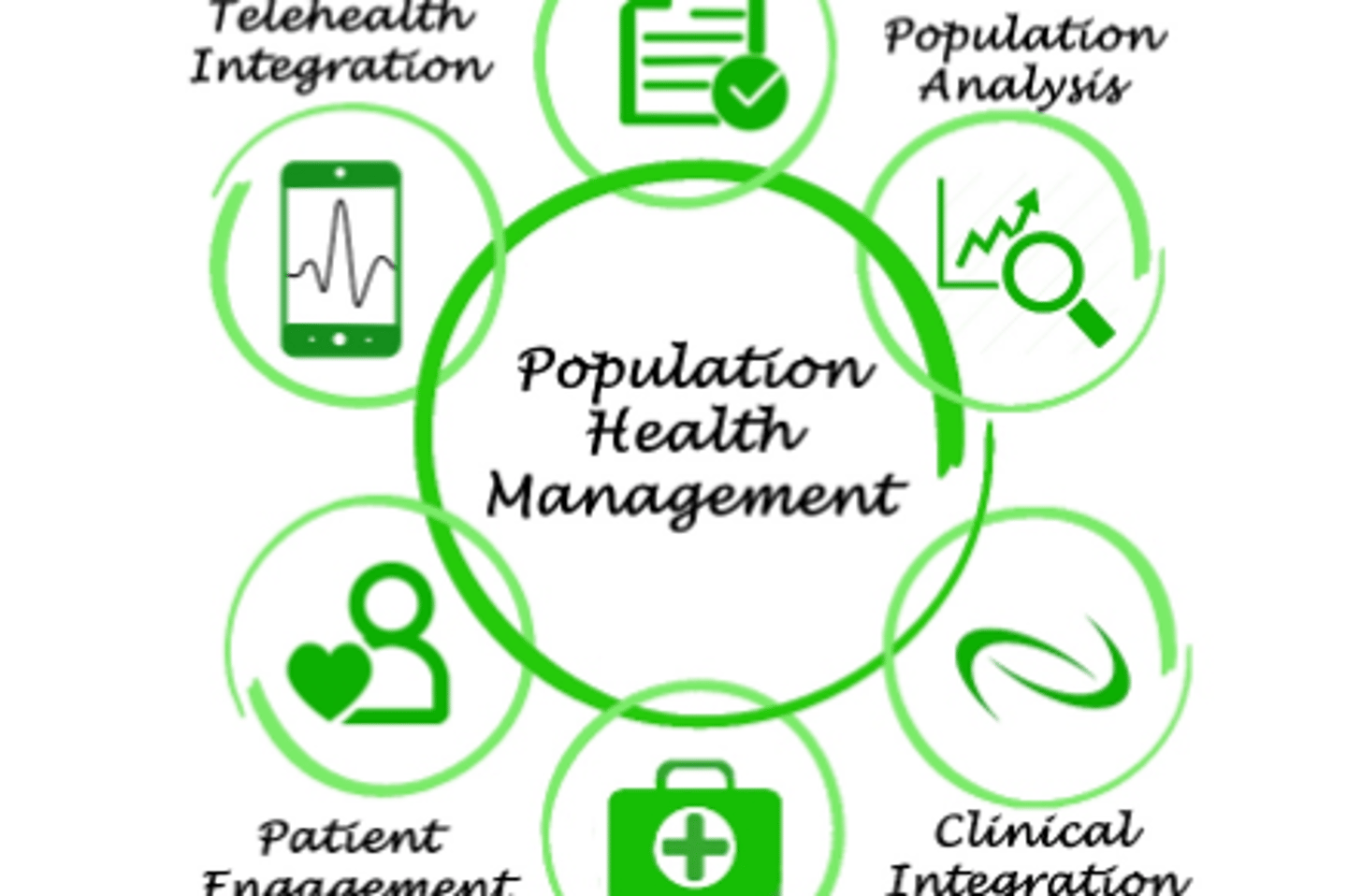
4 Features of Doing
1. Promotion of occupational well-being
2. Occupational balance
3. Balance lifestyle
4. Examining personal and community factors
What can the "being" aspect of population health in occupational therapy be described as?
People's essential nature that drives them to do things
Being
People's essential nature that drives them to do things
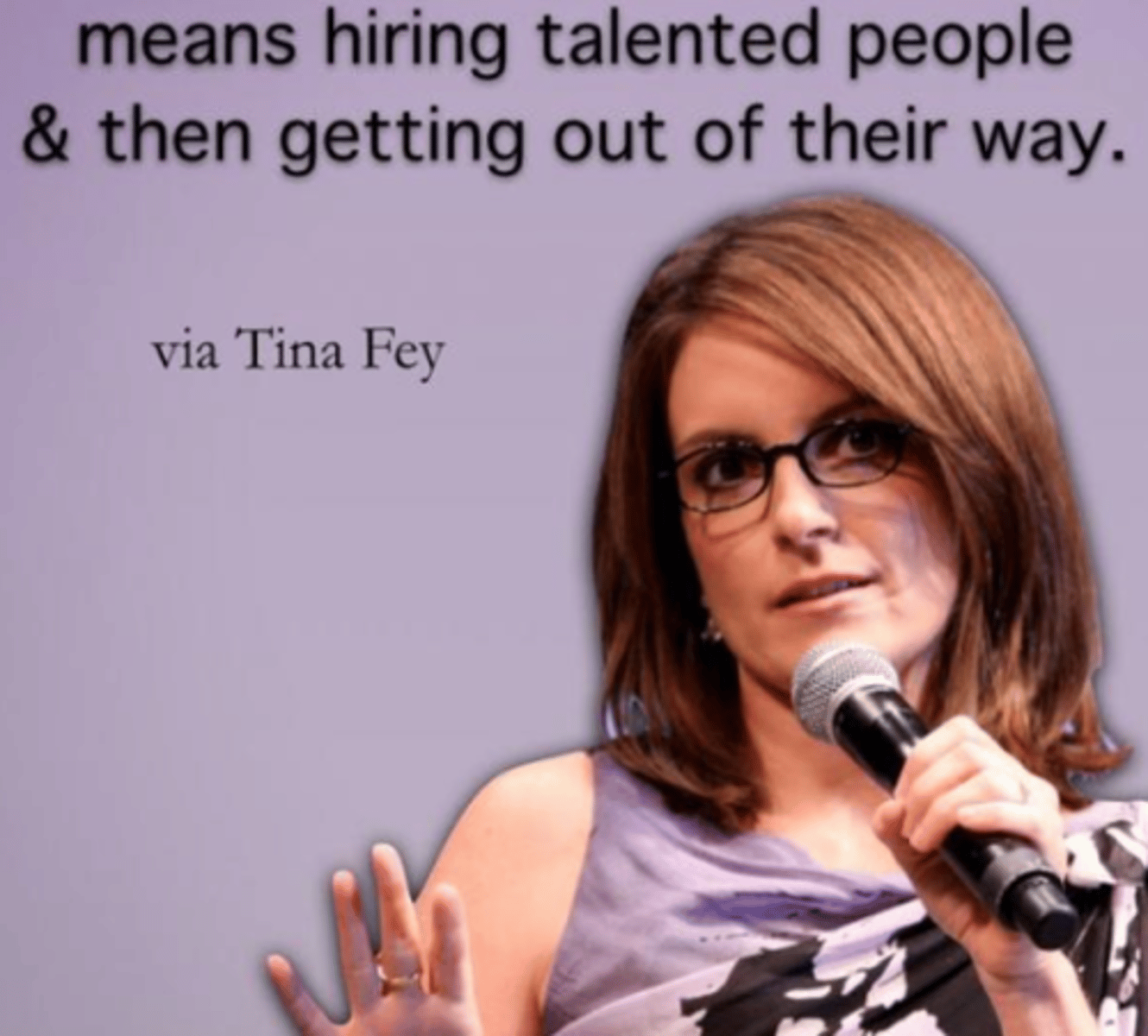
3 Features of Being
1. Shared myths (e.g. black cats are bad luck)
2. Shared values (e.g. working hard, spirituality)
3. Tolerance for different ways of "being" in this world
What can the "belonging" aspect of population health in occupational therapy be described as?
Being accepted by others and feeling secure in relationships and connected to a place
Belonging
Being accepted by others and feeling secure in relationships and connected to a place
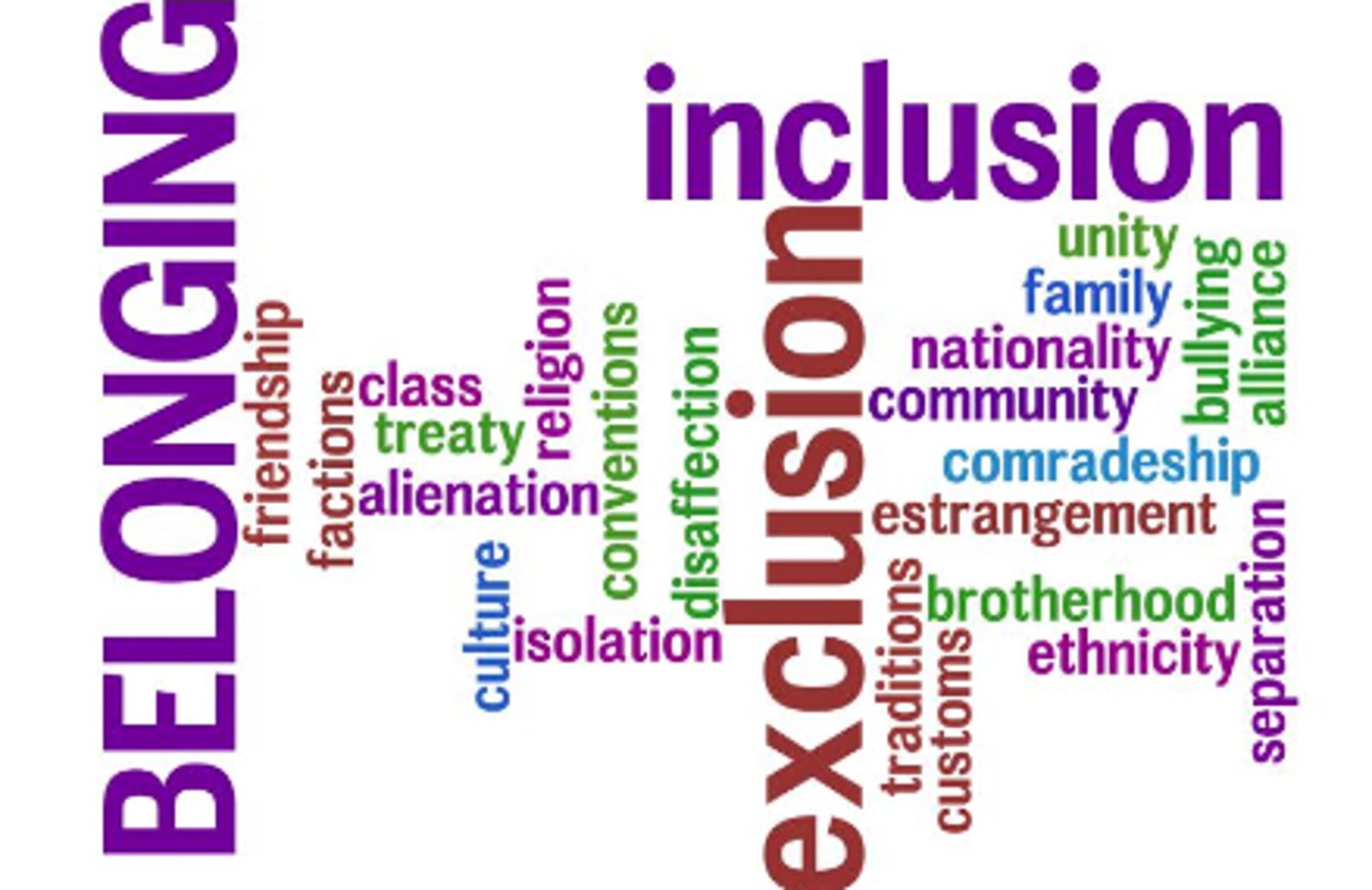
What is an essential feature of belonging for population health in occupational therapy?
Group cohesion
Group Cohesion
Network of relationships holding a group together with collected occupations that create bonds and a sense of common identity/shared history
What can the "becoming" aspect of population health in occupational therapy be described as?
People's development over their lifetimes
Becoming
People's development over their lifetimes

2 Features of Becoming
1. Fulfilling occupational potential
2. Finding occupations which are fulfilling
What do fulfilling occupations allow an individual to gain?
Competence, challenging them at the same time
What are fulfilling occupations based on?
The opportunities afforded to a population according to societal properties
What term can be defined as a combination of individuals, their needs/desires, and the environment in which they reside, work, and play?
Community
Community
Combination of individuals, their needs/desires, and the environment in which they reside, work, and play
What term can be defined as the physical, emotional, social, and spiritual well-being of a group of people who are linked together in some way?
Community health
Community Health
The physical, emotional, social, and spiritual well-being of a group of people who are linked together in some way
What term can be defined as a state of flourishing?
Well-being
Well-Being
State of flourishing
5 Elements of Well-Being
1. Positive emotion
2. Engagement
3. Positive relationships
4. Meaning
5. Accomplishment
What is a fundamental process for achieving health and well-being by facilitating engagement, meaning, and accomplishment?
Occupation
What does the use of occupations decrease?
Risk factors
6 Risk Factors for Occupational Dysfunction
1. Occupational imbalance
2. Occupational deprivation
3. Occupational alienation
4. Occupational delay
5. Occupational interruption
6. Occupational disparities
Occupational Imbalance
A lack of balance or disproportion of occupation resulting in decreased well-being (e.g. occupational patterns that fail to meet an individual's physical and/or psychological needs resulting in stress and a negative impact on health)
Occupational Deprivation
Deprivation of occupational choice and diversity because of circumstances beyond the control of individuals or communities (e.g. poor health, disability, lack of transportation, isolation, homelessness)
Occupational Alienation
Sense of isolation, powerlessness, frustration, loss of control, and estrangement from society or self as a result of engagement in occupation that does not satisfy inner needs
What tasks may result in an experience of occupational alienation?
Tasks that are perceived as stressful, meaningless, or boring
Occupational Delay
Occupational development that does not follow the typical schedule for the acquisition of occupational skills and is associated with occupational performance deficits
Occupational Interruption
A temporary interference with occupational performance or participation as a result of a change in personal, social, or environmental factors
Occupational Disparities
Inequalities or differences in occupational patterns among populations that are often the result of occupational injustice
What does use of occupations increase?
Resiliency factors
7 Resiliency Factors for Occupational Performance
1. Occupational adaptation
2. Occupational coherence
3. Occupational continuity
4. Occupational competence
5. Occupational identity
6. Occupational orchestration
7. Occupational self-efficacy
Occupational Adaptation
The ability to adjust and respond to challenges and changes in circumstances that require modifications in occupational performance or participation
Occupational Coherence
Engagement in occupations that are integrated, consistent, and congruent with one's current and aspirational occupational roles
Occupational Continuity
Engagement in valued and meaningful occupations that provide a continuous sense of occupational identity throughout one's life
Occupational Competence
The degree to which one is able to sustain a pattern of occupational participation that reflects one's occupational identity
Occupational Identity
A composite sense of who one is and wishes to become as an occupational being generated from one's history of occupational participation
Occupational Orchestration
The capacity of individuals to enact their occupations on a daily basis to meet their own needs and the expectations of the many environments in which they are required to function
Occupational Self-Efficacy
The belief in one's capacity to perform occupations to meet one's own needs and the demands of the environment
What is the role of occupational therapy in community and population health?
Prevent and reduce incidence of illness or disease
Reduce health disparities (e.g. low income) among minorities
Enhance mental health, resiliency, and quality of life
Prevent secondary conditions and improve overall health
Promote healthy living practices with respect to cultures
3 Roles of Occupational Therapists in Community Health
1. Promote healthy lifestyles and identify risk factors
2. Infuse occupation into proven health promotion programs
3. Develop/implement occupation-based promotion programs
What should occupational therapists aim to promote for all clients, their families, communities, and populations?
Healthy lifestyles
What should occupational therapists aim to identify?
Risk factors (e.g. tobacco use, unhealthy diet, sedentary lifestyle, substance abuse)
What should occupational therapists not overlook in people living with disabilities?
Risk factors
What should occupational therapists aim to infuse occupations into?
Health promotion programs
How can occupational therapists aim to infuse occupations into health promotion programs?
By adapting already credible programs to assist people living with disabilities (e.g. meal preparation/nutrition in the rehabilitation kitchen at TIRR)
What should occupational therapists aim to develop and implement?
Occupation-based community and population health promotion programs that target people with and without disabilities
Community Centered Practice Framework
A process and an outcome of occupation-based, community centered practice
What does the community centered practice framework focus on?
Achievement of the community's occupational goals, enabling community participation
What are the 4 main components of the community centered practice framework?
1. Community identity (e.g. age, gender, ethnicity)
2. Community occupations (e.g. church, school)
3. Community resources and barriers
4. Participation enablement
Community Identity
Individuals, groups, organizations, and social networks that are members of the community
Is membership in the community fluid, changing over time; yes or no?
Yes
How can an individual's membership in the community change over time?
Geographic location
Climate
Natural and built environments
Population characteristics
Sociocultural elements
What does each member have that supports the community’s shared purpose and goals?
Specific roles
Community Occupations
Occupations important and meaningful to the community as a whole
What do community occupations provide?
Sense of meaning and purpose (e.g. identity, belonging)
What do community members participate in to move in the direction of the shared goal with everyone drawing on their own diverse skill sets, experiences, and expertise?
Co-occupations
What does the community resources and barriers component of the community centered practice framework find?
Factors that facilitate and inhibit community participation (e.g. social capital, policies, infrastructure)
What factor of community participation can be both a resource and a barrier?
Infrastructure
How is the participation enablement component of the community centered practice framework enforced?
Building and sustaining partnerships
Recruiting, educating, and supporting volunteers
Increasing community's public profile
Attracting members/funders
Negotiating and advocating to complete applications
